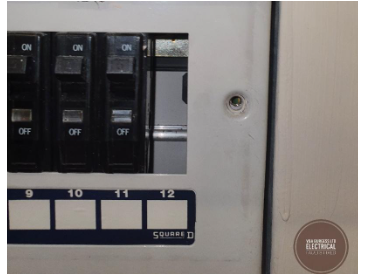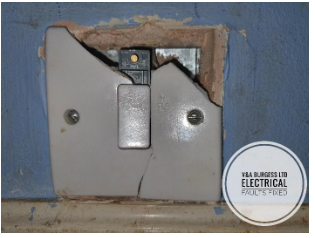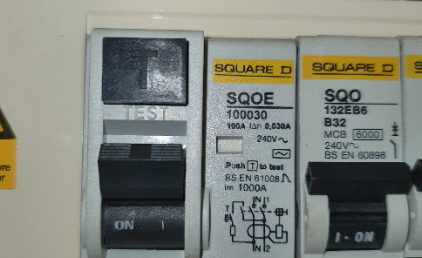Table of Contents
- What is an Electrical Installation Condition Report (EICR)?
- When is an EICR needed?
- Why do we allocate codes?
- What do you need to do if the report has codes?
- What is the meaning of each code?
- Examples of C1 Codes
- Examples of C2 Codes
- Examples of C3 Codes
- Examples of FI codes
- Testing to current safety standards
- Summary
Following a Periodic Electrical Inspection also known as an Electrical Safety Check, Landlord Electrical Check, fixed wire testing, or Safety Certificate. An Electrical Installation Condition Report (EICR) is produced on the condition of the electrical system. Within the report will be a number of observations the qualified electrician or electrical inspector has made on the installation. Each observation will be allocated a code depending upon the severity of electrical danger present.
Back to top1) What is an Electrical Installation Condition Report (EICR)?
An electrical installation condition report is a document produced following an electrical inspection. The inspection process itself takes at least 2 to 3 hours for smaller properties and can extend into several days for large commercial premises. The EICR report is a valuable document to show that electrical maintenance, testing and inspection has been carried out on the installation and to alert the owner of the premises to any electrical dangers that may be present.
Back to top2) When is an EICR needed?
Electrical installations require regular checks and the frequency of inspection will vary depending upon the type of premises that are subject to inspection. A business owner will have a greater responsibility than private domestic homeowners to ensure their premises are safe. Landlords will have to demonstrate to existing and new tenants that their properties are a safe environment and adhere to the electrical safety standards. Regular electrical inspections for property owners not only give peace of mind but are also a legal requirement in many cases.

(Photo: Loop testing is one of the EICR tests)
Private domestic homeowners do not have the burden of ensuring their installation meets the current standards of safety regulations but whilst there is no legal requirement for regular private domestic checks it is highly recommended in order to help prevent electric shocks, potential hazards and to highlight any potentially dangerous defect that may be present.
In 2024, the current requirements for electrical inspections are as follows:
Privately owned domestic homes - No requirement but recommended every 10 years or at change of occupancy such as purchases and sales.
Rented Domestic Accommodation - Routine Checks at 1 year, 5 years for Periodic Inspections producing an EICR.
Residential Accommodation (Houses of Multiple Occupancy) - Routine checks at 1 year, 5 years for Periodic Inspections producing an EICR.
Commercial including offices, shops, and Laboratories - Routine checks at 1 year, 5 years for Periodic Inspections producing an EICR.
Educational Establishments - Routine checks at 6 months, 5 years for Periodic Inspections producing an EICR.
Industrial Premises - Routine checks at 1 year, 3 years for Periodic Inspections producing an EICR.
Group 0 Medical Locations - routine checks at 1 year, 5 years for Periodic Inspections producing an EICR.
Group 1 Medical Locations - routine checks at 6 months, 1 year for Periodic Inspections producing an EICR.
Back to top3) Why do we allocate codes?
The codes are allocated to each observation to allow anyone reading the report to understand the severity of danger that each observation presents to the users of the electrical installation. Without allocating a code to each observation, dangers could be misinterpreted and lead to situations worsening, electric shock risk increasing and the installation falling into a more dangerous condition.
The severity of the issue needs to be correctly relayed to the owner of the premises, the tenants living at the premises or business persons operating from the premises so appropriate actions can be taken to ensure immediate risk of injury and any electrical issues can be addressed correctly.
Back to top4) What do you need to do if the report has codes?
The first step is to talk to the electrician or electrical inspector that carried out the inspection. Clarity on each EICR observation may be necessary to establish what, if any, immediate danger present should be tackled first. Ignoring observations on an EICR report could lead to legal consequences for the building owner, business owner, landlord or homeowner. Once the initial inspection has produced observations, the person that ordered the report has now been informed of electrical issues and it is their responsibility to have them rectified.
Ask the electrician for a quote to rectify the issues on the EICR and ensure that any necessary repairs are carried out. Remedial work following an inspection is common but the extent of the remedial work can vary with the condition of each electrical installation.
Back to top5) What is the meaning of each code?
There are a number of codes that can be applied to observations found in electrical installations.
C1 - The most serious code that indicates that immediate remedial action is necessary as the situation poses an immediate threat to safety and life.
C2 - A code that indicates potential danger and that urgent remedial action should be taken. Without urgent action, the situation could cause electrical fire, electric shock or other problems.
C3 - Where immediate action is not necessary but improvement is recommended. A C3 code today could possibly turn into a C2 or C1 in the future without any action on the identified issues. This is not true in all cases and does depend upon each situation. Best practices are to take necessary steps to try and remedy all C3 codes where possible and practicable to avoid future issues.
FI - Further Investigation required. This code is used where the inspector believes that further inspection, testing or fault finding will lead to the discovery of a dangerous situation.

(Photo: C1 Code, live parts can be touched and C2 Code Consumer unit cover is loose)

(Photo: C1 Code, badly damaged light switch with access to live parts)
Back to top6) Examples of C1 Codes
- Incoming supply cable severely damaged with live parts exposed.
- Mains supply cut out damaged with live parts exposed.
- Meter Tails (Cables) have exposed copper.
- Meter has been damaged and live parts are exposed.
- Mains Isolator has been damaged and live parts are exposed.
- Consumer unit or Fuse Box cover is damaged or missing with live parts exposed as a result.
- A blank is missing from the CU or Fusebox with the ability to touch live parts.
- CU has a hole that allows access to live parts.
- Switchgear in the CU or Fusebox is not to OEM and is allowing access to live parts.
- Electrical circuit cable damaged allowing access to live parts.
- Junction box cover missing allowing access to live parts.
- Plug socket badly damaged allowing access to live parts.
7) Examples of C2 Codes
- Excessive strain on cabling.
- There is no earthing conductor.
- No bonding conductor for parts that require it.
- CU or Fuse Box not secured adequately / loose fixings.
- CU or Fuse Box cover is loose.
- CU of Fusebox in a domestic premises is made of combustible material AND showing signs of thermal damage.
- Rewireable fuse (BS3036) is the incorrect gauge of fuse wire.
- No RCD protection to socket outlets that may be used to power portable equipment outdoors.
- RCD fails to operate in the correct time when tested.
- Too many cables terminated into one point AND signs of thermal damage.
- PVC trunking not adequately supported from premature collapse in the event of a fire.
- Cable is underrated for design current.
- Vulcanised Rubber Cabling (VIR) showing signs of decay.
- No Circuit Protective Conductor (CPC, EARTH) at metal fittings (Class 1).
- RCD protection provided exceeds 30mA.
- No continuity of conductors on ring final circuits.
- Light fitting installed on external wall of an inadequate IP rating for location.
- Accessible socket outlet within 2.5 metres of Zone 1 in a room containing a bath or shower.
- No supplementary bonding where required and no RCD protection for circuits in a room containing a bath or a shower.
8) Examples of C3 Codes
- Earthing conductor is not labelled accordingly.
- Bonding and / or Earthing conductor connections are not accessible.
- The CU or Fuse Box is mounted at a height making access difficult.
- Holes or gaps in a CU have been secured with tape instead of correct blanking covers.
- PVC cable installed externally with no signs of damage.
- Socket outlet mounted too low, damage likely to occur.
- Absence of 30mA RCD protection to lighting circuits in domestic premises.
- Electrical cables have been secured to gas pipe.
- CU or Fuse box installed with restricted access.
- A Type 'AC' RCD is installed where a Type 'A' is required.
- Cables not adequately supported to prevent strain on terminations.
- Circuits not adequately labelled at CU or Fuse Box.
- Incorrect polarity.

(Photo: Possible C3 code, Type ‘AC’ RCD where Type ‘A’ is required)
9) Examples of FI codes
- Unable to determine the size of the earthing conductor.
- A circuit breaker has not been identified for its purpose.
- Insulation resistance test values are lower than the minimum required.
- High resistance measure on ring final circuit conductors indicating possible loose connections.
10) Testing to current safety standards
Classification codes are applied to electrical observations and in accordance with the most up to date and current regulations. Electrical testing should be carried out and compared with the up-to-date version of the wiring regulations in force at the time of testing. Older wiring regulations may not comply with the latest wiring regulations but that does not necessarily mean that they are now dangerous.
Back to top11) Summary
By gaining an understanding of the electrical codes, the manner in which they are applied and under what circumstances, will give you some better understanding of your EICR certificate. As the safety of electrical installations improves it is likely that older wiring systems will no longer meet the latest regulations. This means that older installations will nearly always attract some C3 codes for recommended improvements.
If you are confused about the electrical codes that have been applied to your certificate then get in touch with your electrician for some further explanation, they are the best person to be able to assist.
Back to top
Read more articles
- Log in to post comments


